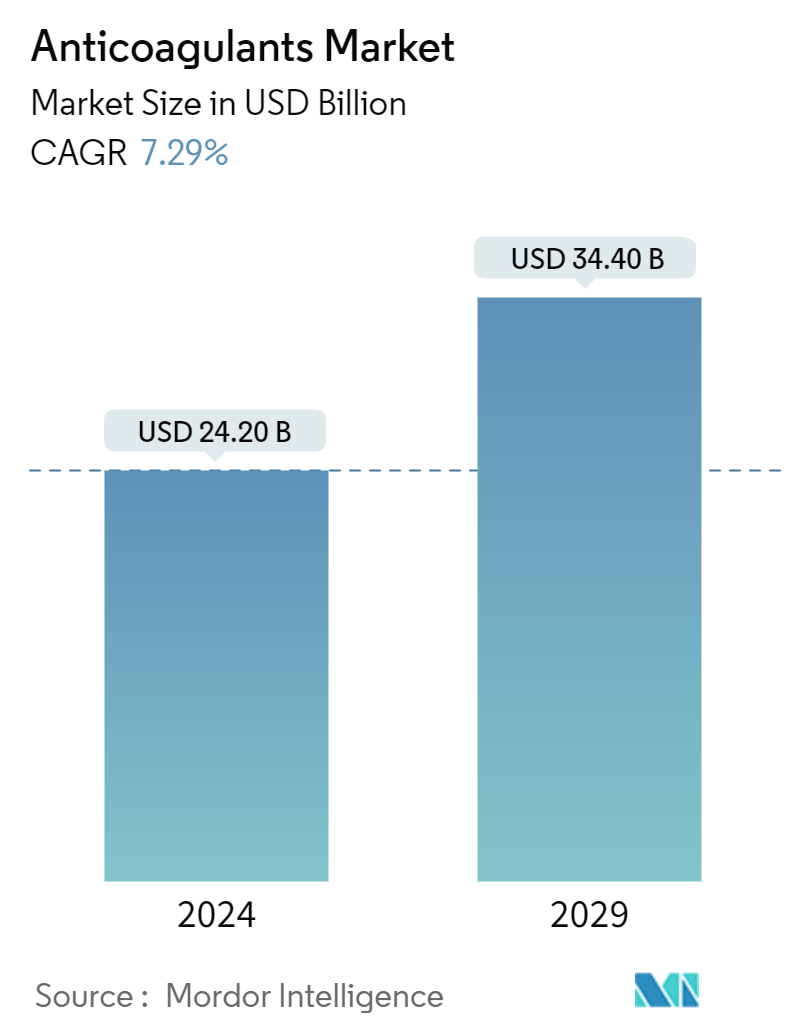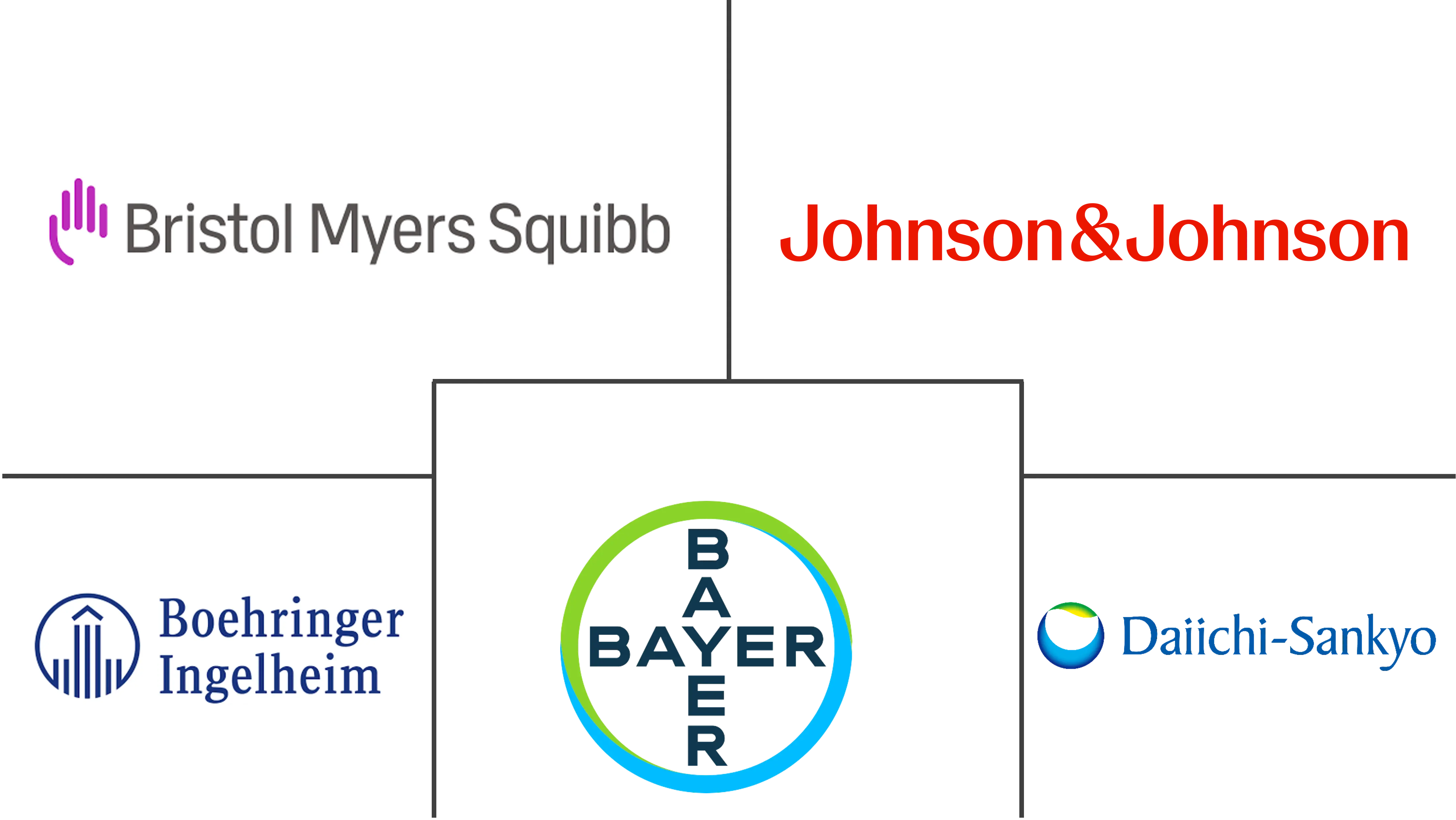Market Size of Anticoagulants Industry

| Study Period | 2019 - 2029 |
| Market Size (2024) | USD 24.20 Billion |
| Market Size (2029) | USD 34.40 Billion |
| CAGR (2024 - 2029) | 7.29 % |
| Fastest Growing Market | Asia Pacific |
| Largest Market | North America |
| Market Concentration | Low |
Major Players
*Disclaimer: Major Players sorted in no particular order |
Anticoagulants Market Analysis
The Anticoagulants Market size is estimated at USD 24.20 billion in 2024, and is expected to reach USD 34.40 billion by 2029, growing at a CAGR of 7.29% during the forecast period (2024-2029).
Factors such as an increase in the incidence of chronic diseases with a rise in the adoption of novel anticoagulant medicines are likely to drive market growth. For example, according to the May 2024 update by the Centers for Disease Control and Prevention, about 1 in 20 adults aged 20 and older have coronary artery disease (CAD) in the United States. Further, as per the same source, every 40 seconds, someone suffers from a heart attack, and nearly 805,000 people in the United States have a heart attack every year. Thus, the growing burden of coronary artery disease is expected to increase the demand for anticoagulants, thereby contributing to the growth of the market.
Moreover, the regulatory approval of anticoagulant products is also propelling the growth of the market. For example, in March 2023, Techdow USA Inc. received US Food and Drug Administration (FDA) approval for enoxaparin sodium (preservative-free) in prefilled syringes for the US market. The launch of Enoxaparin is expected to complement Techdow USA’s existing heparin sodium injection business, which was launched in 2022. Hence, the active presence of key market players and strategic product launches are expected to augment the market growth during the forecast period. Additionally, the demand for anticoagulants in chronic disease therapy is expected to drive market expansion during the forecast period. For instance, as per the BHF report published in 2023, 1,372 anticoagulant and protamine medicines were prescribed during 2021-2022 in Wales for the prevention and treatment of heart and circulatory diseases.
Therefore, the market is expected to witness notable growth during the forecast period due to the increase in chronic disease complications and advancements in anticoagulant therapies coupled with strategic activities by the key players. However, stringent regulation and side effects associated with the treatment will restrain the market growth during the forecast period.
Anticoagulants Industry Segmentation
As per the scope of the report, anticoagulants are medicines used to treat and prevent blood clots that may occur in blood vessels.
The anticoagulants market is segmented by drug class, application, and geography. By drug class, the market is segmented into novel oral anticoagulants (NOACs), heparin, low molecular weight heparin (LMWH), and vitamin K antagonists. By application, the market is segmented into atrial fibrillation/myocardial infarction, deep vein thrombosis (DVT), pulmonary embolism, and other applications. By geography, the market is segmented into North America, Europe, Asia-Pacific, the Middle East and Africa, and South America. The report also covers the estimated market sizes and trends for 17 countries across major regions globally. The report offers the value (USD) for the above segments.
| By Drug Class | |
| Novel Oral Anticoagulants (NOACs) | |
| Heparin and Low Molecular Weight Heparin (LMWH) | |
| Vitamin K Antagonist |
| By Application | |
| Atrial Fibrillation/Myocardial Infarction | |
| Deep Vein Thrombosis (DVT) | |
| Pulmonary Embolism | |
| Other Applications |
| Geography | ||||||||
| ||||||||
| ||||||||
| ||||||||
| ||||||||
|
Anticoagulants Market Size Summary
The anticoagulants market is poised for significant growth, driven by the increasing prevalence of chronic diseases and advancements in technology. Anticoagulants play a crucial role in preventing and treating blood clots, which can lead to severe complications such as heart attacks and strokes. The demand for these medications has been further amplified by the COVID-19 pandemic, as research has explored their potential benefits for infected patients. The market is characterized by the growing adoption of novel oral anticoagulants (NOACs), which offer advantages such as lower bleeding risks and fewer dietary interactions compared to traditional options like warfarin. This shift is particularly notable in developing regions, where NOACs are gaining traction due to their convenience and efficacy.
North America is expected to dominate the global anticoagulants market, supported by a high demand for innovative products and a rising incidence of cardiovascular disorders. The region benefits from a robust healthcare infrastructure and the presence of leading pharmaceutical and biotech companies, which are actively involved in developing new therapeutics. The market is competitive and fragmented, with major players such as Johnson & Johnson, Bayer AG, and Boehringer Ingelheim GmbH driving innovation and product launches. Regulatory approvals, such as those from the FDA for pediatric indications and new formulations, are anticipated to further propel market growth. Despite challenges like stringent regulations and potential side effects, the anticoagulants market is set to expand, fueled by ongoing research and development efforts.
Anticoagulants Market Size - Table of Contents
-
1. MARKET DYNAMICS
-
1.1 Market Overview
-
1.2 Market Drivers
-
1.2.1 Increasing Cases of Chronic Diseases
-
1.2.2 Increase in Development of Anticoagulant Products and Growing Adoption of Novel Oral Anticoagulants (NOACs)
-
-
1.3 Market Restraints
-
1.3.1 Stringent Government Regulations
-
1.3.2 Side Effects Associated with Treatment
-
-
1.4 Porter's Five Force Analysis
-
1.4.1 Threat of New Entrants
-
1.4.2 Bargaining Power of Buyers/Consumers
-
1.4.3 Bargaining Power of Suppliers
-
1.4.4 Threat of Substitute Products
-
1.4.5 Intensity of Competitive Rivalry
-
-
-
2. MARKET SEGMENTATION (Market Size by Value - USD)
-
2.1 By Drug Class
-
2.1.1 Novel Oral Anticoagulants (NOACs)
-
2.1.2 Heparin and Low Molecular Weight Heparin (LMWH)
-
2.1.3 Vitamin K Antagonist
-
-
2.2 By Application
-
2.2.1 Atrial Fibrillation/Myocardial Infarction
-
2.2.2 Deep Vein Thrombosis (DVT)
-
2.2.3 Pulmonary Embolism
-
2.2.4 Other Applications
-
-
2.3 Geography
-
2.3.1 North America
-
2.3.1.1 United States
-
2.3.1.2 Canada
-
2.3.1.3 Mexico
-
-
2.3.2 Europe
-
2.3.2.1 Germany
-
2.3.2.2 United Kingdom
-
2.3.2.3 France
-
2.3.2.4 Italy
-
2.3.2.5 Spain
-
2.3.2.6 Rest of Europe
-
-
2.3.3 Asia-Pacific
-
2.3.3.1 China
-
2.3.3.2 Japan
-
2.3.3.3 India
-
2.3.3.4 Australia
-
2.3.3.5 South Korea
-
2.3.3.6 Rest of Asia-Pacific
-
-
2.3.4 Middle East and Africa
-
2.3.4.1 GCC
-
2.3.4.2 South Africa
-
2.3.4.3 Rest of Middle East and Africa
-
-
2.3.5 South America
-
2.3.5.1 Brazil
-
2.3.5.2 Argentina
-
2.3.5.3 Rest of South America
-
-
-
Anticoagulants Market Size FAQs
How big is the Anticoagulants Market?
The Anticoagulants Market size is expected to reach USD 24.20 billion in 2024 and grow at a CAGR of 7.29% to reach USD 34.40 billion by 2029.
What is the current Anticoagulants Market size?
In 2024, the Anticoagulants Market size is expected to reach USD 24.20 billion.

